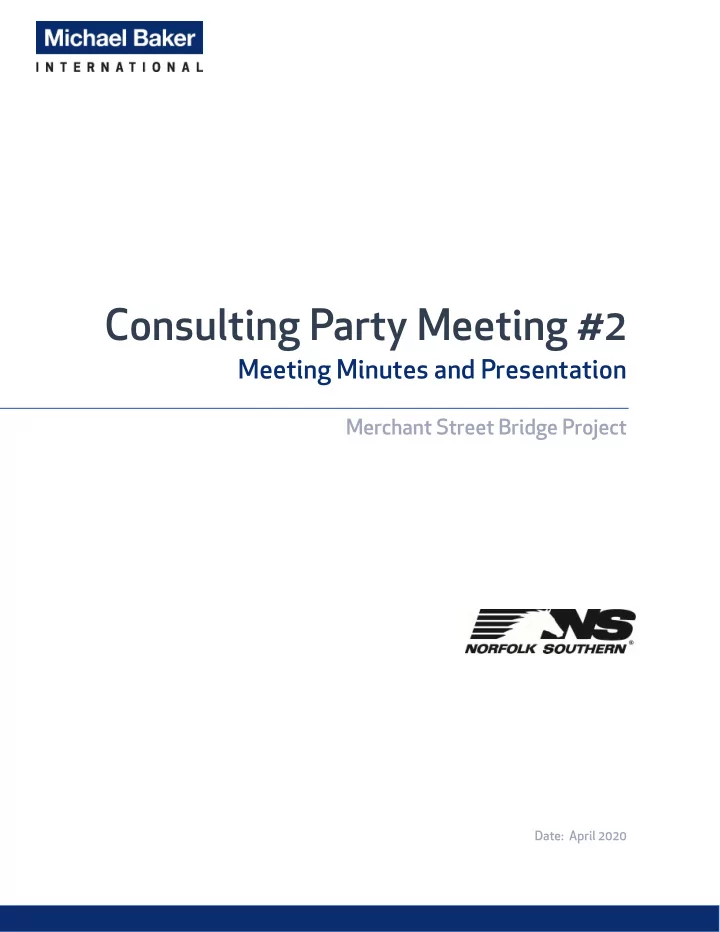

Consulting Party Meeting #2 Meeting Minutes and Presentation Merchant Street Bridge Project Date: April 2020
Project: Norfolk Southern Railway Company (Norfolk Southern) Date: Wednesday, Merchant Street Bridge Project April 22, 2020 Subject: Consulting Party Meeting #2 Time: 7:00 PM By: Michael Baker International (Michael Baker) / Norfolk Place: Video Conference Southern Attendees: Consulting Parties Cheryl Nagle, Pennsylvania State Historic Preservation Office (PA SHPO) Frank Stroker, Pittsburgh History and Landmarks Foundation (PHLF) Dana Cress, Preservation Pittsburgh Melissa McSwigan, Preservation Pittsburgh Mark Fatla, North Side Leadership Conference (NSLC) Susan Rademacher, Pittsburgh Parks Conservancy (PPC) Alison Keating, Pittsburghers for Public Transit Glenn Olcerst, Rail Pollution Protection Pittsburgh (RP3) Barbara Talerico, RP3 Stephanie Joy Everette, City of Pittsburgh, Department of City Planning (DCP) Eric Setzler, City of Pittsburgh, Department of Mobility and Infrastructure (DOMI) Bobby Wilson, Pittsburgh City Council District 1 Mohammed Burny, representing Bobby Wilson, Pittsburgh City Council District 1 Lynne Leher, D.L. Clark Building (DLCB) Lacey Russell, DLCB John DeSantis, 719 Brighton Road (Property Owner) Norfolk Southern (NS) Rudy Husband, Vice President Pennsylvania Department of Transportation (PennDOT) Mark Young, Environmental Manager David Anthony, Historic Preservation Specialist Hannah Stiller, Public Relations Specialist Michael Baker, International, Inc. (Michael Baker) Kirsten Bowen, Project Manger Amy Pinizzotto, NEPA Lead Wendy Berrill, Engineering Design Lead Clayton Fisher, Bridge Lead Jesse Belfast, Architectural Historian Timothy Zinn, Historic Preservation Lead 1
Purpose of the Project: The purpose of the Merchant Street Bridge project is to maintain safe interstate freight rail operations along the Pittsburgh Line to continue the efficient transportation of goods between Chicago and the New York/New Jersey commercial markets. The bridge structure has reached the end of its useful life and engineering inspections have identified a need to address these problems in order to maintain safe interstate rail transportation along the Pittsburgh Line. The bridge carrying the Pittsburgh Line over Merchant Street has safety deficiencies that pose risks to current and forecasted rail traffic increases throughout the United States and within Pennsylvania in particular. Purpose of the Meeting: The purpose of the Merchant Street Bridge Project Consulting Party Meeting #2 was to seek comments on the assessment of effects on historic properties and discuss potential mitigation measures. Because of the mandatory stay‐at‐home order, the meeting was held as a video conference. Kirsten Bowen (Michael Baker) opened the meeting and welcomed attendees to the Merchant Street Bridge Project Consulting Party Meeting #2. She thanked everyone for their flexibility with the virtual format of the meeting and explained the features of the video conference for speaking and submitting comments. Following the welcome, Tim Zinn (Michael Baker) introduced the project team and consulting parties. Presentation: Tim Zinn and Jesse Belfast (Michael Baker) presented the slides in the attached presentation. The following meeting notes record questions and comments from attendees and indicate at which point in the presentation they were received. Questions, Comments, and Discussion: Pennsylvania History Code Consultation (using Section 106 procedures) No questions. Historic Bridge Rehabilitation Analysis (HBRA) Report and Selection of Preferred Alternative No questions. Determination of Effects Report Cheryl Nagle (PA SHPO): Technically the adverse effect is on the Railroad Corridor Historic District resulting from the demolition of a contributing resource, the Merchant Street Bridge. Susan Rademacher (PPC): What will the bridge design look like? Jesse Belfast (Michael Baker): Very similar to existing bridge, size and scale similar, bridge appearance will be generally the same. Visual differences will result from how the new bridge is fabricated using modern fabrication techniques. There will be no trough floor system, rather a series of modern rolled beams. The new bridge will not use riveted built up members but will use welded and bolted connections. Glenn Olcerst (RP3): Regarding PA SHPO’s comment letter on the HBRA Report, the reviewer asked what was the load posting of this bridge and what’s the anticipated loading increase for the project? NS statement of need, anticipates an increase in train volume by 2040. Is the proposed new bridge going to be able to carry the 2040 anticipated load capacity? What will the new bridge capacity be? Rudy Husband (NS): You are not understanding how railroad bridges are designed. Volume of traffic over the bridge has nothing to do with load capacity. There are currently four tracks on the Merchant Street Bridge that can carry four trains simultaneously. The weight of double‐stacked intermodal trains is less than coal trains. Glenn Olcerst (RP3): Norfolk Southern has never had four trains crossing this bridge simultaneously. Rudy Husband (NS): Rail bridges are designed to the standards needed to carry rail traffic. Glen Olcerst (RP3): I am confused about why the historic reviewer was asking if the loading will be increased by 2040 if we aren’t concerned with the loading then. Mark Fatla (NSLC): Why did the historic reviewer inquire about the load and whether it can be increased? 2
Recommend
More recommend